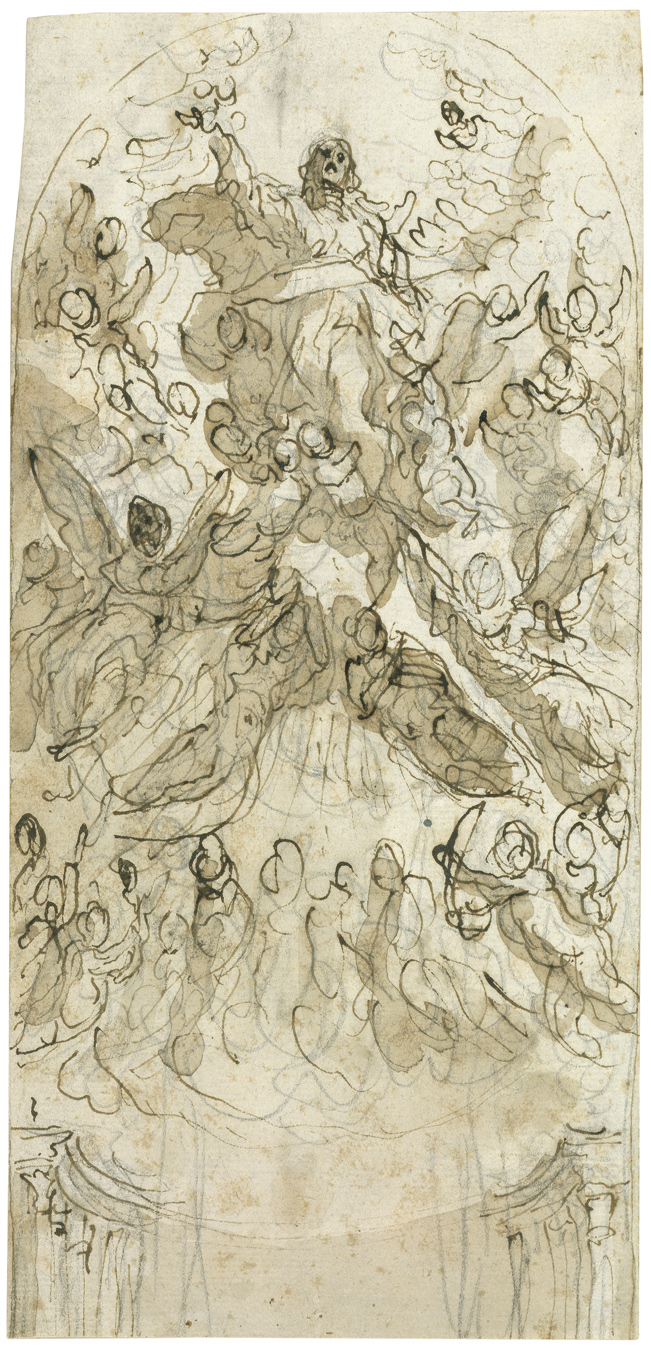Loading the page ...
Alessandro Maganza
(1556–1632, Vicenza)
The Assumption of Mary. Black chalk, pen and brown ink, brown wash. 22.7 x 10.8 cm.
The painter and fresco artist Alessandro Maganza, the most renowned member of this family of artists from Vicenza, was first trained by his father Giambattista before going on to study under Giovanni Antonio Fasolo. After the death of his tutor in 1572 Alessandro spent four years in Venice, where he was exposed to the work of such leading artists of the day as Tintoretto, Palma il Giovane and Veronese. Alessandro must have acquired an extensive knowledge of Venetian painting at some earlier point in his career, as his father was a student and imitator of Titian.
The present drawing is a primo pensiero, an initial sketchy draft for an altarpiece depicting the Assumption of Mary, a recurring theme in Maganza’s oeuvre. Different versions of this subject are to be found in Vicenza Cathedral, in the church of Santa Maria Nascente in Paderno Dugnano, and in the parish church of Santi Nabore e Felice in Griante. Although the overall composition differs considerably, the figure of the Virgin on the altarpiece in Griante is very reminiscent of the Mother of God in our drawing. In general the compositional structure of this drawing is characteristic of Maganza's religious painting. Comparable compositional schemes were used inter alia for the Coronation of the Virgin in the Oratorio del Gonfalone (destroyed in 1945, a photograph of it survives, see W. de Boer (ed.), I gioielli pittoreschi: virtuoso ornamento della città di Vicenza, Florence, 2008, p. 420, no. 400) and the Paradiso in the church of Santi Rocco e Teresa (W. de Boer, idem, p. 420, no. 400). The dense throng of angels and the length of their wings are typical stylistic features which also appear in our drawing. The furious, agitated nature of the linework and the dramatic use of chiaroscuro also show how much Alessandro was influenced by the drawing techniques of such Venetian masters as Veronese and Palma Giovane.
Maganza’s painting strongly reflects the spirit of the Counter- Reformation and its artistic aims. For didactic reasons religious portrayals were to dispense with extravagant or heathen themes and shun any sign of easy-going frivolity. The somewhat stereotypical nature of Maganza’s compositions and his austere, seemingly dogmatic way of rendering figures reflect the pursuit of clarity and general accessibility that is characteristic of this period.
From the Padre Sebastiano Resta Collection (1653 Milan – 1714 Rome, Lugt 2992 a). Waldemar H. de Boer has kindly confirmed the authorship of Alessandro Maganza.
